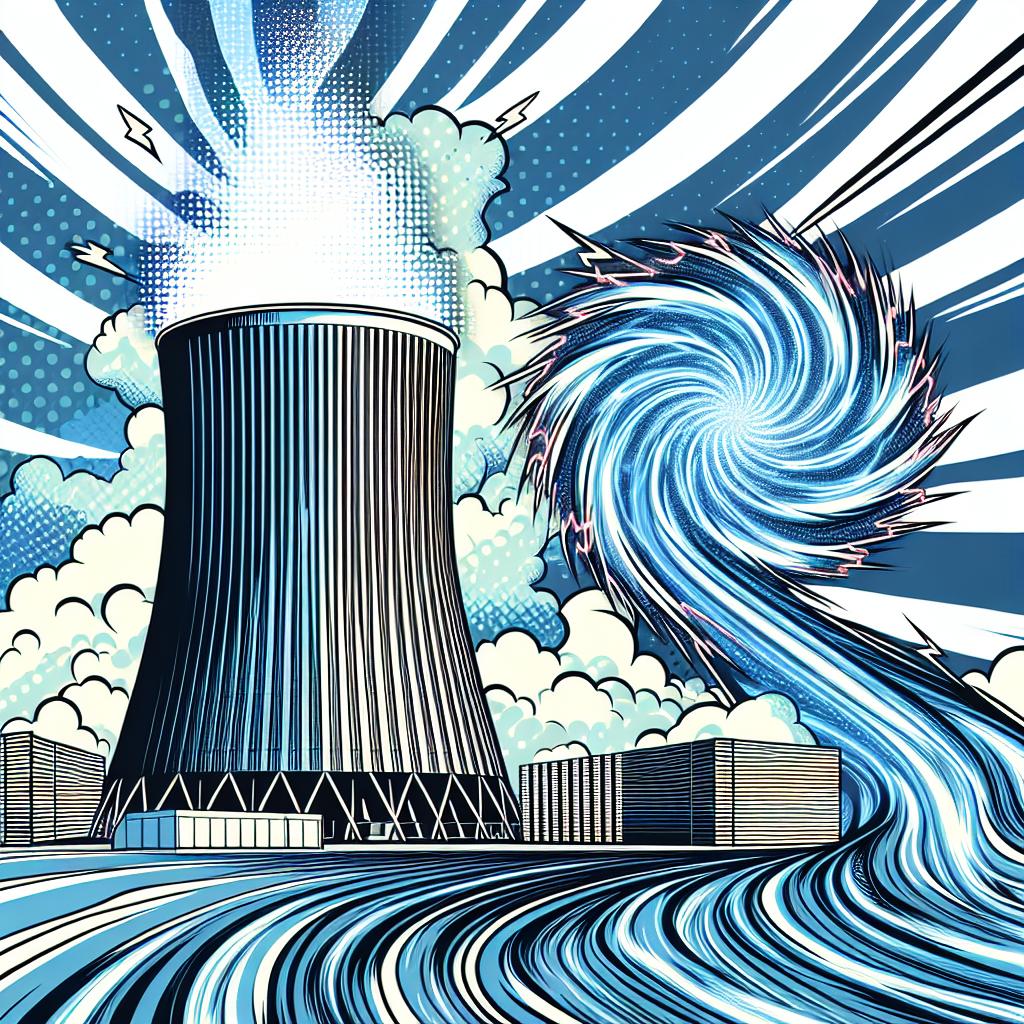
Innovative Nuclear and Cooling Technologies Revolutionize Data Centers Amidst Soaring Energy Demands

TABLE OF CONTENTS
- Introduction
- In the quest to meet soaring energy demands, tech giants are investing in nuclear energy solutions and advanced cooling technologies to power AI-driven data centers, with a focus on sustainability and efficiency.
1. Introduction
This news article explores the interconnected realms of nuclear energy and cooling technologies as solutions to the burgeoning energy demands of data centers, particularly driven by AI advancements. Drawing data from various reports and insider insights, the information sheds light on the innovative strides being made to sustainably power and cool these critical infrastructures.
2. In the quest to meet soaring energy demands, tech giants are investing in nuclear energy solutions and advanced cooling technologies to power AI-driven data centers, with a focus on sustainability and efficiency.
As artificial intelligence and cloud computing continue to drive the exponential growth of data centers, tech giants are turning to revolutionary energy solutions to meet the escalating demands. Microsoft's recent 20-year agreement with Constellation to power its data centers using a reopened nuclear reactor at Three Mile Island exemplifies a significant shift towards nuclear energy. This move is part of a broader trend where companies are exploring small modular reactors (SMRs) and other nuclear technologies as viable alternatives to fossil fuels.
In parallel, cooling technologies are also seeing unprecedented innovation. Traditional air cooling systems, which consume substantial energy, are being phased out in favor of more efficient solutions like immersion cooling and liquid cooling. Companies such as Lenovo and Nvidia are at the forefront, advocating for systems like Lenovo’s Neptune™ technology, which significantly reduces power usage by immersing components in cooling liquids.
The Asia-Pacific region is poised for significant growth in liquid cooling solutions, with the market expected to surge from USD 663.4 million in 2022 to about USD 2.6 billion by 2027. This rapid uptake is fuelled by a dual need to enhance energy efficiency and accommodate higher computing demands from emerging technologies.
In addition to nuclear and cooling innovations, renewable energy sources continue to play a pivotal role in the sustainable transformation of data centers. Companies are exploring partnerships and signing agreements to secure power from solar, wind, and geothermal sources, aiming to reduce carbon emissions significantly.
However, the path forward is not without challenges. The integration of these advanced technologies involves high upfront costs, regulatory hurdles, and the need for significant infrastructural changes. Companies face the daunting task of balancing technological advancements with economic viability and regulatory compliance.
Glossary
- Small Modular Reactors (SMRs) [Technology]: SMRs represent an emerging nuclear energy technology that offers smaller, scalable deployments of nuclear power generation. They are seen as pivotal in meeting the operational demands of data centers with lower carbon footprints. Companies like Amazon and Dominion Energy are actively exploring SMR development for their potential to provide consistent energy supply while minimizing environmental impacts.
- Lenovo’s Neptune™ Technology [Product]: Neptune™ is an advanced water cooling technology developed by Lenovo, designed to enhance data center efficiency significantly. By directly cooling critical server components with liquid, it reduces power consumption and operating costs. This technology addresses the high thermal loads and energy requirements of modern data centers, making it a cornerstone in sustainable cooling solutions.
- Three Mile Island Nuclear Facility [Facility]: This nuclear power plant has gained renewed attention following Microsoft's power purchase agreement to reopen Unit 1, which had been offline since 2019. The facility is central to Microsoft's strategy to power AI-driven data centers sustainably and represents a broader shift in the industry towards using nuclear energy to meet growing energy demands.
Source Documents
- Solar PV Inverter Market Revolutiongo-public-report-en-13740e79-1610-431b-96de-eb6d0e7716fd-0-0
- Eco-Friendly Cooling In Data Centersgo-public-report-en-15113adf-4805-4f91-b681-2353e16a8ebd-0-0
- The next winner of the AI boom is also one of its biggest problemshttps://www.yahoo.com/tech/next-winner-ai-boom-one-090000234.html
- Oklo obtains DOE approval for Aurora nuclear fuel facility design - DCDhttps://www.datacenterdynamics.com/en/news/oklo-obtains-doe-approval-for-aurora-nuclear-fuel-facility-design/
- Pros and Cons of Sodium-Cooled Nuclear Reactors for Data Center Energyhttps://www.datacenterknowledge.com/energy-power-supply/pros-and-cons-of-sodium-cooled-nuclear-reactors-for-data-center-energy
- Kentucky utilities brace for data center impacthttps://www.power-grid.com/td/kentucky-utilities-brace-for-data-center-impact/
- How Google, Amazon, and Microsoft are solving nuclear power's 'big problem'https://ca.finance.yahoo.com/news/how-google-amazon-and-microsoft-are-solving-nuclear-powers-big-problem-171507122.html
- Westinghouse eVinci Microreactor Could Yield 5 MW of Nuclear Power Every 8 Years for AI Data Centers | Data Center Frontierhttps://www.datacenterfrontier.com/energy/article/55232808/westinghouse-evinci-microreactor-could-yield-5-mw-of-nuclear-power-every-8-years-for-ai-data-centers
- Shifts in Lithium and EV Marketsgo-public-report-en-6d8cb351-c0af-440d-be47-c062d35ca5c6-0-0
- Sustainable Data Center Cooling Innovationsgo-public-report-en-726b96b0-7618-4e6a-b185-7e3c3f88dff3-0-0
- Data Center Liquid Cooled Servers Market Projected to Reach CAGR of 18.91% by 2032https://www.openpr.com/news/3695693/data-center-liquid-cooled-servers-market-projected-to-reach-cagr
- Containerized Data Center Market Size | Industry Report [2032]https://www.fortunebusinessinsights.com/containerized-data-center-market-108571
- Microsoft Inks 20 Year Power Purchase Agreement with Constellation to Reopen TMI-1https://energycentral.com/c/ec/microsoft-inks-20-year-power-purchase-agreement-constellation-reopen-tmi-1
- Revolutionizing Data Center Cooling Solutionsgo-public-report-en-c88fb64b-f444-44f1-b371-857ac5448a4f-0-0
- Data center tech is exploding but adoption won't be easy for startups | TechCrunchhttps://techcrunch.com/2024/10/13/data-center-tech-is-exploding-but-adoption-wont-be-easy-for-startups/
- As data centers grow, Amazon and Dominion explore small nuclear reactors - Virginia Businesshttps://www.virginiabusiness.com/article/as-data-centers-grow-amazon-and-dominion-explore-nuclear-development/
- Micro nuclear reactors are being built that can deliver 5MW of power for up to 100 months, producing a staggering 1.2 petawatt-hours of energyhttps://energycentral.com/news/micro-nuclear-reactors-are-being-built-can-deliver-5mw-power-100-months-producing-staggering-12
- APAC Sustainable Data Center Industry Analysis & Outlook 2024-2029: Focus on Microgrids, Eco-Diesel, Natural Gas, Hydrogen, Fuel Cells, Vegetable Oil (Hvo) Fuel, and Nuclear Energy Generationhttps://www.globenewswire.com/news-release/2024/10/14/2962618/28124/en/APAC-Sustainable-Data-Center-Industry-Analysis-Outlook-2024-2029-Focus-on-Microgrids-Eco-Diesel-Natural-Gas-Hydrogen-Fuel-Cells-Vegetable-Oil-Hvo-Fuel-and-Nuclear-Energy-Generation.html
- Renewables - Energy System - IEAhttps://www.iea.org/energy-system/renewables